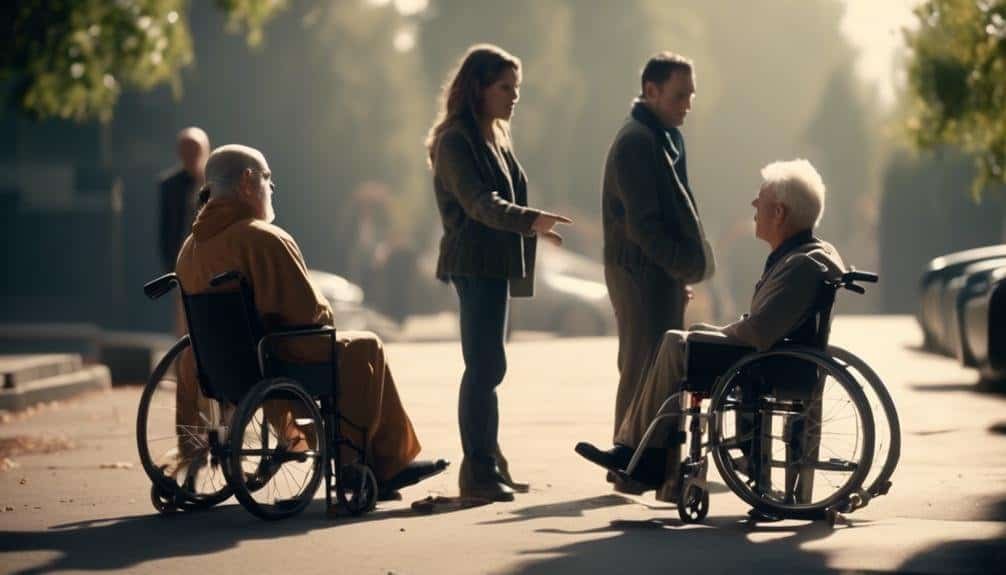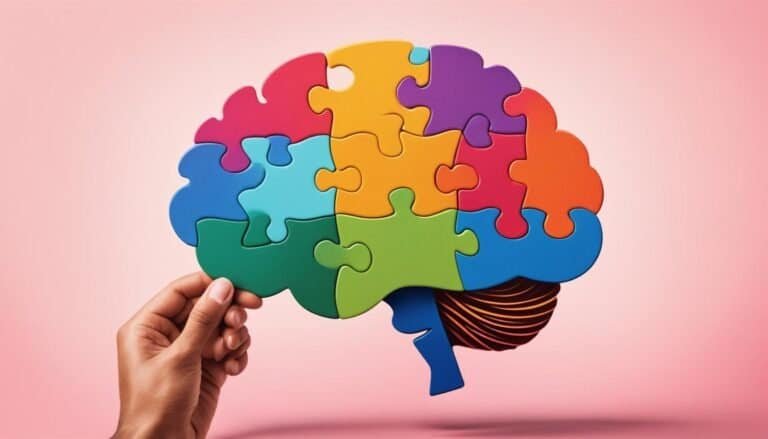Disability Etiquette: Dos and Don'ts
Understanding and practicing disability etiquette is an essential aspect of fostering an inclusive and respectful society. In our interactions with individuals with disabilities, it is crucial to be mindful of our words, actions, and attitudes.
From using respectful language to offering assistance in a considerate manner, there are several key dos and don'ts that can significantly impact the experiences of people with disabilities. By adhering to these guidelines, we can create an environment that values and respects the diverse needs and perspectives of all individuals.
Key Takeaways
- Approach interactions with empathy and understanding
- Use person-centered language instead of defining individuals by their disabilities
- Offer assistance in a respectful and empowering manner
- Hold events in venues with ramps, elevators, and accessible restrooms
Understanding Disability Etiquette
Understanding disability etiquette is essential for creating an inclusive and respectful environment for individuals with disabilities. It is crucial to approach interactions with empathy and understanding, considering the diverse needs and experiences of people with disabilities. Respecting diversity and promoting disability inclusion involves being aware of the cultural nuances and unique challenges that individuals with disabilities may face.
Empathy plays a fundamental role in understanding disability etiquette. It involves recognizing the emotions and experiences of others, which is particularly important when interacting with individuals with disabilities. By putting oneself in their shoes, one can gain a deeper understanding of their needs and preferences, fostering a more inclusive and supportive environment.
Moreover, disability inclusion requires a heightened level of cultural awareness. This entails understanding the different cultural, social, and personal factors that shape the experiences of individuals with disabilities. By acknowledging and respecting these diverse perspectives, one can ensure that interactions are considerate and accommodating.
Embracing disability etiquette in this manner not only promotes inclusivity but also fosters a more empathetic and understanding society.
Using Respectful Language
When communicating with individuals with disabilities, it is important to use language that is respectful, inclusive, and considerate of their preferences and identities. By using person-centered language and respectful terminology, we can create an environment that promotes inclusivity and equality.
Here are some dos and don'ts for using respectful language when interacting with individuals with disabilities:
- Do Use Person-Centered Language: Instead of defining individuals by their disabilities, focus on their abilities and use phrases such as 'person with a disability' instead of 'disabled person.'
- Don't Use Outdated or Offensive Disability Terminology: Avoid using terms such as 'handicapped,' 'crippled,' or 'mentally retarded,' as these are considered disrespectful and outdated.
- Do Prioritize Inclusive Communication: Use language that includes and respects individuals with disabilities, ensuring that everyone feels valued and understood.
- Don't Make Assumptions: Avoid making assumptions about a person's abilities or limitations based on their disability. Instead, ask individuals how they prefer to communicate or offer assistance.
Offering Assistance Appropriately
To further foster an environment of inclusivity and respect, it is essential to consider how to offer assistance appropriately when interacting with individuals with disabilities.
When offering assistance, it is important to do so in a respectful and empowering manner. Supportive gestures such as asking, 'May I offer you assistance?' or 'How can I support you?' show respect for the individual's autonomy and agency.
It is equally important to be attentive to their response and to honor their preferences. Empowerment through assistance involves recognizing the person's capabilities while offering help when needed. For instance, instead of assuming someone needs help, it is advisable to first observe if they require assistance and then offer support accordingly.
Additionally, when providing assistance, it is crucial to communicate clearly and respectfully. Using a calm and reassuring tone can help in promoting a positive interaction.
When individuals with disabilities feel respected and empowered through assistance, it contributes to creating an inclusive and supportive environment for all.
Being Mindful of Accessibility
Being mindful of accessibility is crucial for creating an environment that is inclusive and accommodating to individuals with disabilities. When planning events or designing spaces, it's important to consider the needs of all participants and ensure equal access.
Here are some key considerations for being mindful of accessibility:
- Accessible Events: Ensure that events are held in venues with ramps, elevators, and accessible restrooms. Provide sign language interpreters, captioning, or assistive listening devices for individuals with hearing impairments. Consider the layout and seating arrangements to accommodate mobility aids.
- Inclusive Design: Embrace universal design principles to create spaces and products that can be used by people of all abilities. This may involve using adjustable height tables, tactile signage, and ergonomic furniture. Incorporate color contrast and clear signage for individuals with visual impairments.
- Disability Accommodations: Be proactive in offering disability accommodations such as alternative formats for materials, reserved seating, and designated parking spaces. Communicate the availability of accommodations and encourage attendees to request any specific needs in advance.
- Equal Access: Ensure that information about events, programs, and services is available in accessible formats such as large print, braille, or electronic documents. Utilize websites and digital platforms that are compatible with screen readers and other assistive technologies.
Respecting Personal Space
When interacting with individuals with disabilities, it's important to be mindful of their physical boundaries and personal space. Always ask before offering assistance, and respect their decision if they decline.
Additionally, be aware of and respectful towards any mobility aids they may be using, as these are essential tools for their independence and should not be interfered with without permission.
Physical Boundaries and Disability
Respecting personal space is a fundamental aspect of disability etiquette, requiring mindfulness and consideration in all interactions. When it comes to physical boundaries and disability, it's important to be aware of the following:
- Always ask for consent before offering physical assistance to someone with a disability.
- Respect the individual's personal space and avoid touching them without permission.
- Be mindful of mobility aids and assistive devices, and avoid touching or moving them without the individual's consent.
- Understand that each person's comfort level with physical contact may vary, so it's crucial to communicate openly and respectfully about personal space boundaries.
Being sensitive to personal space awareness and respecting boundaries is essential in creating a supportive and inclusive environment for people with disabilities.
Asking Before Assisting
Always seek permission before offering assistance to someone with a disability, respecting their personal space and autonomy. Consent before helping is crucial in ensuring that the individual's boundaries are respected. It is essential to recognize that individuals with disabilities have the right to independence and control over their bodies.
When offering assistance, it is important to communicate clearly and ask how you can help. Be mindful of their personal space and avoid making assumptions about their needs. Respectful assistance boundaries involve understanding that everyone has different preferences and comfort levels.
Respect for Mobility Aids
Showing consideration for an individual's personal space includes respecting their mobility aids, recognizing their importance in facilitating independence and mobility. When interacting with someone who uses mobility aids, it's important to be mindful of their specific needs and preferences.
Here are some dos and don'ts to keep in mind:
- Do: Ask before touching or moving their mobility aid.
- Do: Allow enough space for the person to maneuver with their aid comfortably.
- Don't: Lean on or move their mobility aid without permission.
- Don't: Make assumptions about their abilities based on their use of mobility aids.
Being aware of different types of mobility aids and offering respectful support demonstrates an understanding of the individual's autonomy and promotes an inclusive environment.
Avoiding Assumptions
When interacting with individuals with disabilities, it is important to approach each person as an individual and avoid making assumptions about their abilities or limitations. Avoiding assumptions is crucial in fostering an inclusive environment. Stereotyping and generalizing disability can lead to misunderstandings and hinder meaningful connections. It's essential to recognize that disability is diverse and multifaceted, encompassing a wide range of conditions and experiences. Each person's abilities and challenges are unique, and assumptions based on generalizations can be harmful.
Instead of making assumptions, it's best to communicate directly with the individual. If there are uncertainties about how to best support or interact with a person with a disability, it's appropriate to respectfully ask them directly. This demonstrates a willingness to understand their specific needs and preferences.
Additionally, it's important to remember that not all disabilities are visible, and assuming that someone does or does not have a disability based on appearance can be misleading.
Communicating Effectively
Continuing to foster an inclusive environment, effective communication with individuals with disabilities requires a thoughtful and respectful approach that acknowledges the diverse and unique nature of disability experiences. When communicating with individuals with disabilities, it's essential to consider the following:
- Non-Verbal Cues: Pay attention to non-verbal cues such as facial expressions, body language, and gestures. These cues can provide important information about the individual's feelings and thoughts.
- Active Listening: Engage in active listening by giving the person your full attention, maintaining eye contact, and showing genuine interest in what they are saying. This demonstrates respect and validates their experiences.
- Empathy: Approach conversations with empathy and understanding. Put yourself in their shoes and strive to comprehend their perspective. Empathy fosters a supportive and compassionate environment for effective communication.
- Respect Personal Space: Be mindful of personal space and physical boundaries. Some individuals with disabilities may have specific spatial needs, and it's important to be respectful of their personal space.
Including Everyone in Conversations
Inclusive conversations with individuals with disabilities involve actively engaging all participants and valuing their contributions as integral to the exchange of ideas and experiences. Active listening is crucial in ensuring that everyone, regardless of their abilities, feels heard and included in conversations.
When engaging with individuals with disabilities, it's important to practice active listening by giving them your full attention, maintaining eye contact, and providing verbal and nonverbal cues to show that you are actively engaged in the conversation.
Using inclusive language is another essential aspect of including everyone in conversations. Inclusive language means using terminology that does not exclude or offend individuals with disabilities. It involves being mindful of the words and phrases used, avoiding derogatory language, and being open to learning about preferred language from individuals themselves.
Educating Others on Disability Etiquette
When it comes to educating others on disability etiquette, it's important to emphasize the significance of respecting personal boundaries, using person-first language, and offering assistance in a polite and considerate manner.
These key points can help foster a more inclusive and supportive environment for individuals with disabilities, promoting understanding and empathy.
Respect Personal Boundaries
Understanding and respecting personal boundaries is a crucial aspect of educating others on disability etiquette. When interacting with individuals with disabilities, it's important to acknowledge and honor their boundaries. Here are some key points to consider:
- Ask for consent before offering assistance: Always seek permission before providing help, as some individuals may prefer to manage tasks independently.
- Respect physical space: Be mindful of personal space and avoid touching mobility aids or service animals without permission.
- Listen and observe: Pay attention to cues and verbal/non-verbal communication to understand the individual's needs and preferences.
- Follow their lead: Let the person take the lead in conversations and interactions, allowing them to set the pace and direction.
Use Person-First Language
Respecting individuals with disabilities begins with using person-first language, which emphasizes the person over their disability, promoting dignity and inclusivity. Using inclusive language is empowering to individuals with disabilities as it acknowledges their humanity before their condition. Below is a table highlighting the difference between person-first language and identity-first language:
| Person-First Language | Identity-First Language |
|---|---|
| Person with a disability | Disabled person |
| Individual with autism | Autistic individual |
| Child with Down syndrome | Down syndrome child |
Offer Assistance Politely
In social interactions, it can be considerate to offer assistance to individuals with disabilities in a polite and respectful manner, ensuring that their autonomy and dignity are upheld. When approaching individuals with disabilities to offer assistance, it is crucial to do so in a way that respects their independence and agency.
Here are some dos and don'ts for offering assistance politely:
- Do ask if the person would like help before providing it.
- Do wait for a response and respect their decision, whether they accept or decline assistance.
- Don't make assumptions about the person's needs or abilities without consulting them first.
- Don't touch or assist the person without their consent, as it's important to respect personal boundaries and autonomy.
Approaching individuals with disabilities in a respectful manner fosters positive and inclusive interactions.
Advocating for Inclusive Environments
Creating inclusive environments for people with disabilities requires intentional effort and a commitment to understanding diverse needs and perspectives. Advocating for inclusive environments involves creating empathy, promoting awareness, fostering understanding, and building inclusivity. It is essential to recognize the unique challenges individuals with disabilities may face in various environments and to proactively address these challenges to ensure equal access and participation for all.
One crucial aspect of advocating for inclusive environments is promoting awareness and education. This involves providing training and resources to increase understanding of different disabilities, their impact, and the potential accommodations that can enhance accessibility. By fostering a culture of empathy and understanding, organizations and communities can create environments where individuals with disabilities feel valued and included.
In addition, building inclusivity involves actively seeking input from people with disabilities to understand their experiences and perspectives. This collaborative approach ensures that the specific needs of individuals with disabilities are considered and addressed in the design of physical spaces, policies, and programs.
Ultimately, advocating for inclusive environments is a continuous process that requires ongoing commitment and effort to create spaces where everyone, regardless of ability, can fully participate and contribute.
Conclusion
In conclusion, it is essential to adhere to disability etiquette to create an inclusive and respectful environment for individuals with disabilities.
By using respectful language, offering assistance appropriately, being mindful of accessibility, and advocating for inclusive environments, we can ensure that everyone feels valued and included.
Let's work together to break down barriers and create a more accessible and inclusive society for all.








